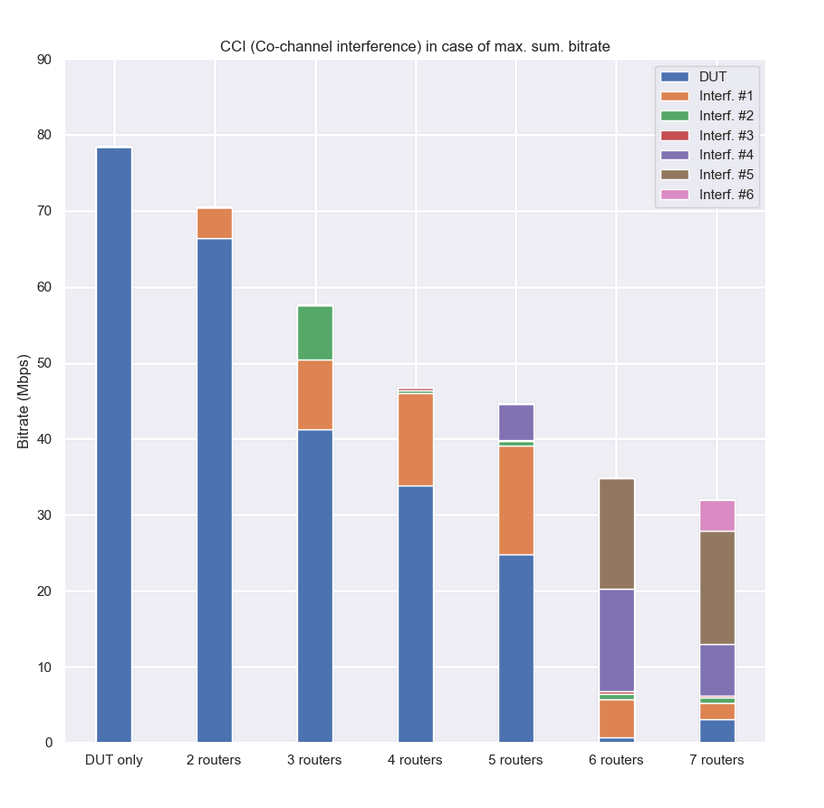CCI: Co-channel Interference
How do devices share channel resources?
The first suggestion that WiFi devices share channel resources equally has not been confirmed by experiments (fig. 1).
What is the reason for this?
The devices of the considered standard 802.11 are using the CSMA / CA (Carrier sensing multiple access a with collision avoidance) mechanism as a multiple access scheme.
CS - Carrier Sense – means that the environment is considered empty if nothing above a certain noise level has been recorded in it.
CA - Collision avoidance - means that the transmission is carried out after the environment has been empty for a certain period of time (the only possible technology for resolving collisions for wireless communication).
There are several types of the inter-frame gaps, which determine the time after which the environment can be considered empty:
SIFS (Short Inter-frame Space) is used to transfer service information: ACK, request to send (RTS), clear-to-send (CTS).
PIFS (Point-Coordinated Inter-frame Space) is used when both the station and the access point use the Point-Coordinated Function (PCF) mode, in which access to the point is not carried out on a competitive basis, but is regulated by the point itself (little-known function on the market).
DIFS (Distributed-Coordinated Inter-Frame Space) is used for everything that is not transmitted from SIFS, as a rule, the user information.
After release of the environment and the end of the interframe gaps, a certain amount of time, which is called the contention window, should pass. This time interval is selected randomly and is doubled when collisions occur. Without this interval, all competing devices would make synchronous attempts to access the environment, which would lead to new collisions.
Reducing the length of the contention window allows the vendor to increase the likelihood of access to the environment, and therefore to increase the speed of their points due to the greater consumption of shared resources.
How does RSSI between two routers affect CCI?
Theoretically, a specific RSSI value should not affect the CCI: the signal from the competing AP should simply pass the threshold after which the environment will be marked as occupied. The 802.11 standards have the following energy thresholds:
ED - energy detection (-65 dBm) – the threshold at which the environment is marked as occupied by non-Wi-Fi devices
CS - carrier sense – the threshold at which the preamble and PLCP (Physical Layer Convergence Protocol) header can be decoded
The last-mentioned threshold is -95 dBm. In other words, any signal that overcomes even such a small threshold can fill the NAV of neighbors, occupying their environment (a typical problem of Wi-Fi networks in large apartment buildings).
In reality, a decrease in RSSI (distance between APs) can lead to the fact that at the values close to the threshold indicators, the competing device can periodically be out of sight of a certain AP, and this in turn can reduce the probability of interference.
Why is the CCI case better than the difference in 1, 2, or 3 channels?
The CCI case is inherently not a case of electromagnetic interference - devices only compete for the environment, waiting for a free time slot. Moreover, devices operating on one channel can reserve the environment for a certain period of time using NAV (Network Allocation Vector), which is a field in the transmitted frame where the time reserved by a certain device is recorded.
The intervals of access scheme to the environment using NAV[2]: the station sends an RTS (request to send), the receiver responds with a CTS (clear-to-send) as confirmation; the other stations fill in their NAV, which correspond to the required time for sending service-based and personal data.
The ACI, on the contrary, is a case of electromagnetic interference. The spectrum of channels can overlap and affect each other. If the signal of a neighboring channel exceeds a certain threshold, it can switch the CCA (Clear Channel Assessment) mechanism into the busy environment state. Since the process becomes more chaotic than the CCI, the interference from neighboring channels usually causes more damage to the transmission speed.



